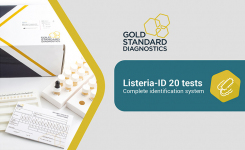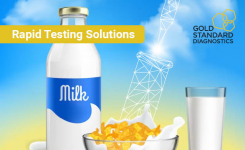
Updated: 9 Sept 2019
Key Points
- One species, Listeria monocytogenes, is an important foodborne pathogen capable of causing serious illness
- There are well established traditional methods, but these take up to five days to produce a result
- Many alternative rapid methods have been developed, most capable of reducing detection times by 50% or more
Up until the 1980s, Listeria was considered a rather rare and little known bacterial genus. Discovered around 100 years ago, it was a very occasional cause of meningitis and septicaemia, especially in newborn babies, but received little attention. All that began to change in 1981, when it was first discovered that Listeria monocytogenes could be transmitted by contaminated food. Foodborne outbreaks of listeriosis were reported in North America and Europe in the 1980s, and the incidence of the disease rose steadily year-by-year. In the UK, a peak of nearly 300 cases was reached in 1988 and this is thought to have been the result of a single foodborne outbreak associated with pork pâté.
These outbreaks led the World Health Organisation to conclude that L. monocytogenes is an environmental contaminant mainly transmitted to humans through food. Although the incidence of listeriosis is at least 100 times lower than those of other foodborne pathogens, such as Campylobacter and Salmonella, the seriousness of the disease, the high mortality rate (up to 40% in some outbreaks) and the fact that it mainly affects vulnerable sections of the population, has focused a great deal of attention on L. monocytogenes. It has now become the target for much of the microbiological testing carried out by the food industry.
What is Listeria monocytogenes?
Bacteria of the genus Listeria are Gram-positive, facultatively anaerobic, non-spore forming rods and are common in the natural environment. The genus currently contains six species, L. monocytogenes, L. innocua, L. welshimeri, L. seeligeri, L. ivanovii and L. grayi, and four subspecies. Four species have been implicated in cases of human illness, but L. monocytogenes is by far the most important and is the cause of most reported cases of human infection. The species is made up of at least 13 different serotypes, all of which can cause listeriosis, but the most commonly found in human infection is serotype 4b.
L. monocytogenes can cause severe, life threatening infections. Pregnant women, newborn babies, the elderly and the immuno-compromised are particularly at risk. The infective dose for vulnerable individuals is not known, but could be very low (<100 CFU/g) in some cases. The incubation period is typically 30 days, but can vary from 1-90 days. Initial flu-like symptoms are often followed by vomiting and diarrhoea and in a few cases potentially fatal meningitis and septicaemia may develop. Infection in pregnant women can lead to miscarriage and overall mortality rates of 30% are typical in outbreaks.
Transmission of infection is now thought to be mainly foodborne and person-to-person transmission is rare, although pregnant women may pass infection to the foetus. After the peak of the late 1980s, the incidence of listeriosis fell in North America and Europe as control measures were introduced by the food industry. In recent years, around 1,600 cases of listeriosis are recorded in the USA annually, with approximately 260 deaths (Source: CDC). In Europe approximately 1,470 cases were recorded in 2011, but the number of cases has shown signs of increasing again, especially in the elderly, for reasons that are not entirely clear. Food borne outbreaks remain a serious problem, especially in North America. For example, a nationwide outbreak linked to cantaloupes in the USA in 2011 caused at least 147 cases of illness and may have contributed to as many as 33 deaths (Source: CDC).
L. monocytogenes is ubiquitous in the environment and can be isolated from soil, plant material, animals and even marine fish and seafood. It has also been found in a very wide variety of food products, but its presence is particularly hazardous in chilled processed foods with a long shelf life, such as smoked fish, pâtés, soft cheeses and ready-to-eat cooked meats. This is because it is able to grow slowly at temperatures as low as 0oC and may therefore multiply to dangerous levels in refrigerated foods unless controlled. Listeria species are also common colonisers of food factories where they may form biofilms that are difficult to remove. These biofilms can act as reservoirs of persistent L. monocytogenes contamination for processed foods if not controlled. The presence of Listeria species in the food factory environment is often used as an indicator for L. monocytogenes contamination.
Many countries have introduced legislation to try to control the incidence of listeriosis and in many cases regulations require microbiological monitoring of L. monocytogenes. For example, in the EU, the Microbiological Criteria Regulation requires regular testing of ready-to-eat foods for L. monocytogenes and imposes limits of absent in 25g at the point of production and up to 100 CFU/g at end of shelf life. Environmental sampling and testing in processing areas is also required. In the USA a ‘zero tolerance’ approach has been taken for L. monocytogenes in ready-to-eat foods and regular testing is encouraged to demonstrate compliance.
How do I Screen Foods for Listeria?
A wide variety of foods may be tested for the presence of Listeria spp. and for L. monocytogenes, but processed chilled products, such as dairy products, cooked meats and smoked fish make up the bulk of samples. Environmental samples often include swabs taken from food preparation surfaces, and cold wet locations, like drains and chillers.Food and environmental samples should be tested as soon as possible after collection. If this is not possible, samples should be stored at 4oC. The cells survive well in frozen foods, but samples should be kept frozen prior to testing.
Composite samples from individual food lots can be prepared by blending samples in enrichment broth media. Typically, 25g food samples are cultured in detection testing and duplicate samples should be retained for enumeration if a detection test gives a positive result.
What are the Traditional Methods for Detecting Listeria in Foods?
There are current ISO horizontal methods for the detection and enumeration of L. monocytogenes in food and animal feed. ISO 11290-1:1996 is a method for the detection of L. monocytogenes, while ISO 11290-2:1998 is a method for enumeration. Both methods were amended in 2004 to include modified media. Similar standard methods have been published elsewhere by other bodies, notably in the USFDA Bacteriological Analytical Manual (BAM).
The first stage in traditional detection methods for food and environmental samples is usually a pre-enrichment culture in a liquid medium such as Buffered Listeria Enrichment Broth (BLEB), or Half-Fraser broth, incubated at 30oC for 24 hours. Pre-enrichment media may contain selective agents to inhibit the growth of competing micro-organisms, but usually at lower concentrations than those used in selective enrichments. The pre-enrichment culture is than subcultured into selective enrichment media, such as Fraser broth and Oxoid Novel Enrichment (ONE) broth - Listeria, and incubated for a further 24 hours at 35-37oC.
The selective enrichment culture is inoculated on to one or more selective agar media and incubated at 37oC for 24-48 hours. The amended ISO method specifies the chromogenic medium Agar Listeria according to Ottaviani and Agosti (ALOA) and one other selective agar. A variety of alternatives are available, including Modified Oxford agar, Palcam agar and LPM agar, all of which utilise aesculin hydrolysis by Listeria spp. to produce distinct colonies. Several selective chromogenic agar media specifically designed for the differentiation of L. monocytogenes are also available. Examples include bioMérieux ALOA® One Day agar, Oxoid Chromogenic Listeria agar (OCLA), and CHROMagar™ Listeria.
Where detection methods show a positive result for Listeria spp. or L. monocytogenes in food and environmental samples, it may be necessary to quantify the result. Typically, this is done by preparing sample dilutions in buffered peptone water, or enrichment broth without supplements, plating each dilution onto ALOA, or another selective agar medium, and incubating at 37oC for 24-48 hours. Typical colonies can then be counted and confirmed.
How do I Get Fastest Results for Listeria?
Here is a list of kits that can rapidly test for Listeria in food and environmental swabs. It can take up to five days to obtain a result using traditional methods of detection for Listeria spp. For this reason a substantial number of alternative rapid screening methods have been developed to produce results more quickly for food and environmental samples. Many of these are available commercially and have been successfully validated by the AOAC and/or AFNOR. The AOAC database of performance tested methods contains almost 50 products for the rapid detection of Listeria spp. and L. monocytogenes – more than for any other foodborne pathogen.Listeria spp. and L. monocytogenes rapid test and screening kits utilise several different technologies, including immunomagnetic separation, EIA- and ELISA-based assays incorporating fluorescent or colorimetric detection, simple lateral flow assays incorporating immunochromatographic technology, and molecular techniques such as DNA hybridisation and PCR-based assays, many of which now include real-time detection. Some methods can be automated to screen large numbers of samples. Almost all rapid test protocols include a selective enrichment culture, sometimes shortened to 24 hours, and then apply rapid detection techniques to replace culture on selective agars and further confirmatory tests. Most can claim to produce a result in around half the time taken by traditional methods and certain PCR-based assays are capable of detecting Listeria within 30 hours.
Some rapid tests, notably real-time PCR-based methods, can also be used to enumerate Listeria and/or L. monocytogenes in positive samples.
How do I Confirm and Identify Listeria in Foods?
There are well established confirmation and identification procedures for Listeria spp and for L. monocytogenes.Preliminary identification based on colony appearance on chromogenic and other selective agar media is traditionally confirmed using classical biochemical and morphological tests. Key tests are a positive catalase reaction, motility, β-haemolysis, aesculin hydrolysis and acid production without gas from glucose, maltose and salicin, but no acid production from mannitol.
Another useful confirmatory test for Listeria spp is the Christie-Atkins-Munch-Peterson (CAMP) test, which can help confirm species by testing for haemolysis enhancement on sheep blood agar in the presence of other haemolytic bacteria.
Listeria isolates can be further characterised by serological typing. Typing can be important in investigating foodborne disease outbreaks and in tracking individual strains of L. monocytogenes through the food chain and in the environment.
What Rapid Methods Are There for Listeria Testing in Foods
Many rapid confirmation and identification methods have been developed for Listeria spp. and a large number have been developed into commercial products. In addition many of the rapid detection kits mentioned above can also be used for confirmatory testing.
Biochemical confirmation can be accomplished using commercial identification systems such as the API Listeria test strip from bioMérieux and Remel’s Micro-ID® Listeria.
Immunological identification and confirmation tests based on latex agglutination, enzyme immunoassay (EIA) and enzyme-linked immunosorbent assay (ELISA) have been developed for Listeria spp. and lateral flow test strips have also been developed by several manufacturers using immunochromatographic technology.
A number of molecular methods for confirmation are available. Isolates can be further characterised by differences in rRNA using a technique called ribotyping, which has been automated and commercialised by Hygiena’s RiboPrinter® system.
Like to get the latest updates on food pathogen detection products sent to your email? Subscribe to the rapidmicrobiology eNewsletter

























